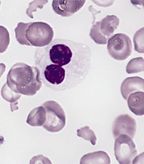Secondary Cancer Risk Found With Multiple Myeloma Maintenance Therapies
Multiple myeloma patients are at increased risk of developing myelodysplastic syndrome or acute leukemia after maintenance lenalidomide or thalidomide treatment, according to a new study.
Patients with multiple myeloma may develop myelodysplastic syndrome-associated cytogenetic abnormalities (MDS-CA) after treatment with maintenance lenalidomide or thalidomide after melphalan exposure, increasing the risk for clinical MDS/acute leukemia, according to the results of a retrospective study published online in Blood.

Therapy-related myelodysplastic syndrome
“Multiple myeloma patients are living much longer than they did 10 to 15 years ago,” said Saad Usmani, MD, of the Myeloma Institute for Research and Therapy at the University of Arkansas for Medical Sciences, Little Rock, Arkansas. “We have to recognize that there is a small subset of patients who are at risk of developing secondary hematologic malignancies when they receive a combination of melphalan with either thalidomide or lenalidomide.”
Prior research has shown an association between lenalidomide and an increased risk for MDS and acute leukemia when the agent was given as a maintenance therapy or concomitantly with melphalan in patients with multiple myeloma.
In this study, Usmani and colleagues conducted a retrospective analysis of 1,088 patients with multiple myeloma who had cytogenetic data available.
Patients had undergone treatment with either Total Therapy 2 (TT2; n = 668), Total Therapy 3a (TT3a; n = 303), or Total Therapy 3b (TT3b, n = 177). Patients treated on the experimental arm of TT2 had applied thalidomide with induction, consolidation, and maintenance until relapse. Treatment with TT3a applied bortezomib and thalidomide during induction and consolidation, and thalidomide during maintenance. TT3b substituted lenalidomide during maintenance.
MDS-CA was diagnosed in 11% of patients, with 4% of patients classified as having persistent MDS-CA. Ultimately, 3% of patients developed clinical MDS or acute leukemia requiring treatment.
Data indicated that patients treated with TT3a and TT3b had a higher incidence of clinical MDS than those patients treated with TT2.
The researchers also examined risk factors associated with the development of MDS-CA, as well as clinical MDS and acute leukemia. The use of TT3b, as well as age older than 65 years, male gender, and elevated levels of beta-2-microglobulin, were all linked with an increased risk for developing MDS-CA.
“Efforts are underway to identify this small group of patients at the time of diagnosis and potentially avoid the use of thalidomide or lenalidomide maintenance in those patients,” Usmani said. “This study is a retrospective analysis but supports the findings of three phase III randomized trials-CALGB 101104, MM-015, and IFM 2005-02-regarding the risk of secondary cancers with use of lenalidomide maintenance after melphalan exposure.”
Newsletter
Stay up to date on recent advances in the multidisciplinary approach to cancer.
Highlighting Insights From the Marginal Zone Lymphoma Workshop
Clinicians outline the significance of the MZL Workshop, where a gathering of international experts in the field discussed updates in the disease state.